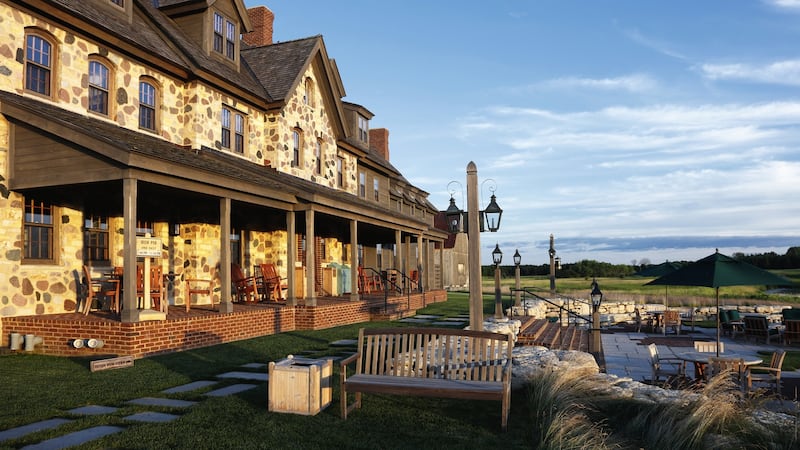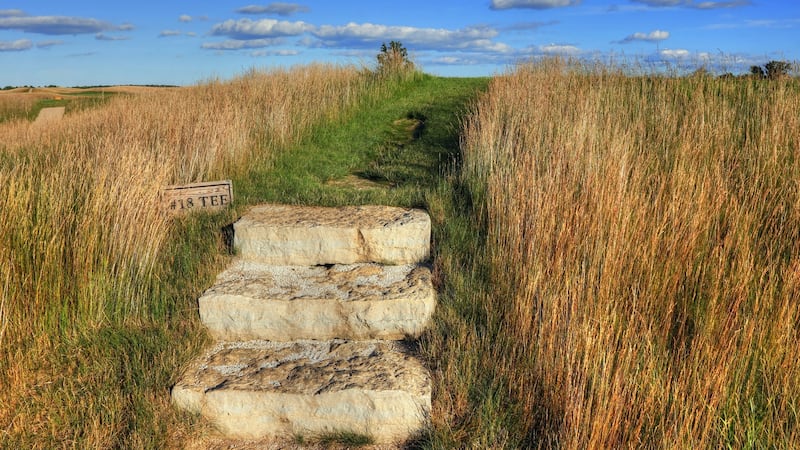As magnificent as the visual images are of Erin Hills, a golf course just over a decade old but carved out of the Wisconsin landscape by a retreating glacier some 11,000 years ago, the 117th edition of the US Open is more than just about moving to new terrain; it is about a chance for the USGA to effectively wipe the slate clean after a number of controversial championships in recent years.
They’ve dirtied their bibs, now it’s time to clean up the act. But can they?
Last year’s US Open at Oakmont certainly beat Banagher for how the USGA handled the Dustin Johnson rules issue in the final round – with Shane Lowry cast as a character in the drama.
Holy wow! Here's your @usopengolf preview pic.twitter.com/VDLUdYiF4o
— Wesley Bryan (@wesleybryangolf) May 30, 2017
As if to prove that it is an organisation with gender balance, the subsequent US Women’s Open at CordeValle was also marred by rules controversy, with Ana Nordqvist the fall girl for how her rules violation was handled.
Just to recall, Johnson – en route to a breakthrough Major title – played most of his round with a question mark hanging over whether or not he would receive a one-stroke penalty (a situation which also affected other players given they didn’t know where exactly they stood). It was only after he finished his round that the American did eventually get confirmation that he would incur the penalty stroke.
During the storm, Rory McIlroy took to social media and called it “amateur hour” from the USGA, who – a day later – issued a statement accepting, that, “upon reflection, we regret the distraction caused by our decision to wait until the end of the round to decide on the ruling . . . while our focus on getting the ruling correct was appropriate, we created uncertainty about where players stood on the leaderboard.”

In Nordqvist’s case, she was issued with a two-stroke penalty during a play-off with champion Brittany Lang for touching the sand in playing a shot from a bunker (only after high definition, slow-motion video replays). There was delay (a hole later) in informing Nodqvist of the imposition of the penalty, and then the timing of that information resulted in Lang changing her playing strategy on the final hole of a three-hole shoot-out.
The handling by the USGA of those two incidents was shambolic, with golf’s integrity questioned. Yet, it wasn’t as if they were standalone issues.
As recently as the 2015 US Open at Chambers Bay, the USGA came in for criticism. Henrik Stenson said putting on the greens was akin to “putting on broccoli” and the legendary Gary Player opined: “(it’s) the worst golf course I might ever have seen as a professional golfer”.
Ian Poulter, too, fired some vocal shots at the time, calling the greens “simply the worst, most disgraceful surfaces I have ever seen on any tour”.
The Dustin Johnson situation, the Chambers Bay situation . . . they’re so fresh in the memory that it would seem the USGA are under pressure to get it right this time.
Although Phil Mickelson – who most likely won’t be playing after deciding to attend his daughter’s school graduation instead – remarked recently at The Players that effectively one right won’t correct all the wrongs. As he put it, “I don’t know if doing one thing right is going to fix that, but . . . !”
We’ll see if there is any benefit of the doubt for past failings given if it all goes sweet and dandy at Erin Hills, but the USGA’s traditional mission statement – “The toughest test in golf!” – has been to protect par as if it were some kind of gold standard.
To achieve the aim, the USGA usually have narrow fairways and thick rough. The green complexes are allowed to become baked firm, and there are times pins are placed on slopes to accentuate the challenge to an impossible level. This heightened difficulty has enabled the US Open to stand out from all other championships.
But it’s almost as if the body has been asking for trouble, as highlighted by the Johnson rules situation last year and the savaging – by numerous players – of Chambers Bay, a course only eight years old when playing host to the famous championship.
The USGA’s set-up strategy has been to ask the hardest of hard questions. Even before they took control of the course set-up from the clubs, that seemed to be the mantra. It was after the 1955 US Open at Olympic Club – where Ben Hogan took three shots to extricate his ball from penal rough in a play-off which he lost to the unheralded Jack Fleck – that the USGA took over. But it was not to be plain sailing by any means.

And, over the years, the US Open – as wonderful and as memorable as many tournaments proved – showed an ability like no other to cause controversy and consternation. Even Arnold Palmer, the mildest of them all, was left exasperated by the examination set at Winged Foot in 1974 when Hale Irwin’s seven-over-par 287 was sufficient for victory.
After that championship, the USGA competition chairman Sandy Tatum was asked if they were trying to embarrass players.
“We’re not trying to humiliate the best players in the world, we’re simply trying to identify them,” he responded.
And, then, there was Shinnecock Hills in 2004. That was the time the USGA responded to the fact that 11 players had the temerity to record sub-par rounds in the first round. A decision was taken to make the links play firmer, so they stopped watering the course. By the final round on Sunday, they had lost the course and greenkeeping staff were forced to water greens during play in an effort to make them any way playable. The most badly affected was the seventh hole, and although four players had already played it, a decision was made to belatedly water it between groups.
Tiger Woods claimed the USGA had “lost it” in how they set up the course that year. Mickelson remarked: “I played some of the best golf of my life, I hit some of my best shots, I putted better than I probably have ever putted and I still couldn’t shoot par [in the final round]. That, surely, cannot be acceptable.” Mickelson finished runner-up to Retief Goosen.
The USGA’s Mike Davis conceded: “It was a great learning experience . . . when it comes to a US Open, you’ve got the world’s best players, and you’re trying to set it up as the hardest event of the year. It’s easy to go from that point to having a set-up where well-executed shots are penalised.”
“It was a great deal embarrassing,” said former USGA executive director Frank Hannigan after the tournament. In fact, only 18 per cent of players managed to hit that seventh green in regulation during the final round when round scores averaged 78.7, the second highest scoring of any US Open. By the way, the US Open returns to Shinneock Hills next year!
So, all eyes are on Erin Hills this time. As spectacular as it is, the questions – as is the USGA’s way – are set to be difficult, albeit on a Par 72 course which is not the norm for the US Open.
In a recent interview with Golfweek, Australian Adam Scott claimed it was up to the USGA to up their game and to "take control".
“They’ve taken criticism for the last two years, I’m sure they’re not liking it. They’re going to have to run a really good event. Hopefully they get it right this time, just from a playability standpoint,” said Scott, who added: “Let’s just have something that’s a challenge and interesting, not just playing brutal. Maybe it is time to do away with the even-par target . . . maybe we should get the numbers out of our heads and try a new strategy.”
As it happens, defending champion Dustin Johnson made use of a missed cut at last week’s Memorial tournament to spend the weekend at Erin Hills. Get this! It is not the traditional narrow fairway kind of golf course. DJ described it as “wide open, a big golf course with plenty of room and very playable.”

And Jason Day, who also paid an advance visit, described it as “a great golf course,” unlike any other US Open course he had played.
Maybe, after all, this could provide a saving grace for the USGA after the controversy of recent years; and let the hard questions be answered without any hullabaloo. Erin Hills is an opportunity to get it right.
All you need to know about Erin Hills
Erin Hills, sounds a bit Irish doesn’t it?
Well, that’s because it is in Erin, Wisconsin, a town given its name by an Irish immigrant called John Whelan. Originally from the Aran Islands, Whelan and his family arrived in the US in 1932 and first settled in Boston before moving his family to Wisconsin. It was his suggestion to call the town – some 55 miles north-west of Milwaukee – Erin.
Is it a links course?
Not in the true tradition, given that it is almost 2,000 miles from Erin to the Pacific and 900 miles to the Atlantic coast. However, the three architects – Michael Hurdzan, Dana Fry and Ron Whitten – collaborated to create a course that contains links-like characteristics. A significant number of trees were removed from the site but, in the main, the course designers allowed the existing rolling hills – a landscape which evolved from a glacier – to determine the routing. The course features a number of kettle lakes . . . and also eskers, which should make Shane Lowry feel at home.
Has it hosted a US Open before?
No. This is a first. The course only opened for play in 2006, which makes it a brave and bold step for the USGA to give it its Major championship. However, Erin Hills successfully hosted the US Amateur championship in 2011 and Golf Digest magazine named it as the 44th Greatest Course in the USA out of the top 100.
Any interesting holes?
All of them really, but the second – a drivable Par 4 of 338 yards – features a semi-blind tee-shot. Those looking to drive the green will need to hit a very precise shot to the smallest putting surface on the course. In contrast, the Par 5 18th measures all of 637 yards with the onus on players to use strategy. There are 25 bunkers on the hole and players will look to stay out of trouble and have a scoring club in hand for their third shot to the green. It is the first time since Pebble Beach in 1992 that the US Open will be staged on a Par 72.












